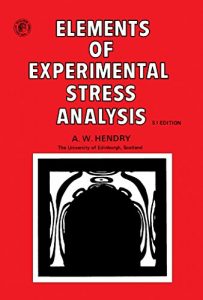نام کتاب: Elements Of Experimental Stress Analysis. Structures And Solid Body Mechanics Division
نویسنده: A. W. Hendry و B. G. Neal
ویرایش: ۱
سال انتشار: ۱۹۷۷
کد ISBN کتاب: ۹۷۸۰۰۸۰۲۱۳۰۱۹
فرمت: PDF
تعداد صفحه: ۱۹۹
انتشارات: Pergamon Press
Description About Book Elements Of Experimental Stress Analysis. Structures And Solid Body Mechanics Division From Amazon
Elements of Experimental Stress Analysis describes the principles of the techniques and equipment used in stress analysis and suggests appropriate applications of these in laboratory and field investigations. Examples from the field of civil engineering are used to illustrate the various methods of analysis.
This book is comprised of 12 chapters and begins with a discussion on the use of models, scale factors, and materials in experimental stress analysis. The next chapter focuses on the application of load to the element under test, with emphasis on the means of creating the required forces; the means of applying these forces to the test piece; and the means of measuring the forces. The reader is then introduced to the principles of various types of strain gauges, as well as the methods of calculating stresses from strains in the case of elastic materials. Subsequent chapters explore two-dimensional photoelasticity; the frozen stress method and surface coating techniques; structural model analysis; special instruments for dynamic stress analysis; analogue methods for dealing with stress problems; and how to select a method of stress analysis.
This monograph will be of use to all undergraduate and postgraduate students who require a basic knowledge of experimental stress analysis, and also to practicing engineers who may be concerned with experimental investigations in one way or another.
درباره کتاب Elements Of Experimental Stress Analysis. Structures And Solid Body Mechanics Division ترجمه شده از گوگل
المان ها از تحلیل تنش تجربی توصیف اصول تکنیک ها و تجهیزات مورد استفاده در تجزیه و تحلیل تنش و نشان می دهد برنامه های کاربردی مناسب از این در تحقیقات آزمایشگاهی و میدانی. نمونه هایی از زمینه مهندسی عمران استفاده می شود برای نشان دادن روش های مختلف تجزیه و تحلیل.
این کتاب از ۱۲ فصل تشکیل شده و با بحث در مورد استفاده از مدل، عوامل مقیاس، و مواد در تجزیه و تحلیل تنش تجربی آغاز می شود. فصل بعد با تمرکز بر اعمال بار به عنصر تحت آزمون، با تاکید بر استفاده از ایجاد نیروهای مورد نیاز است. استفاده از استفاده از این نیروهای به آزمونه؛ و استفاده از اندازه گیری نیروهای. خواننده است و سپس به اصول از انواع مختلف فشار سنج، و همچنین به عنوان روش محاسبه تنش از گونه های در مورد مواد الاستیک معرفی شده است. فصل های بعد کشف فتوالاستیسیته دو بعدی؛ روش استرس و پوشش سطح تکنیک های یخ زده؛ تجزیه و تحلیل مدل ساختاری؛ ابزار های ویژه ای برای تجزیه و تحلیل تنش پویا. روش آنالوگ برای برخورد با مشکلات استرس؛ و چگونه به انتخاب یک روش تجزیه و تحلیل تنش.
این رساله را استفاده به همه دانش آموزان کارشناسی و کارشناسی ارشد که نیاز به یک دانش پایه از تجزیه و تحلیل تنش تجربی، و همچنین به مهندسان تمرین که ممکن است با تحقیقات تجربی در یک راه یا دیگری مربوط باشد.
[box type=”info”]![]() جهت دسترسی به توضیحات این کتاب در Amazon اینجا کلیک کنید.
جهت دسترسی به توضیحات این کتاب در Amazon اینجا کلیک کنید.![]() در صورت خراب بودن لینک کتاب، در قسمت نظرات همین مطلب گزارش دهید.
در صورت خراب بودن لینک کتاب، در قسمت نظرات همین مطلب گزارش دهید.

